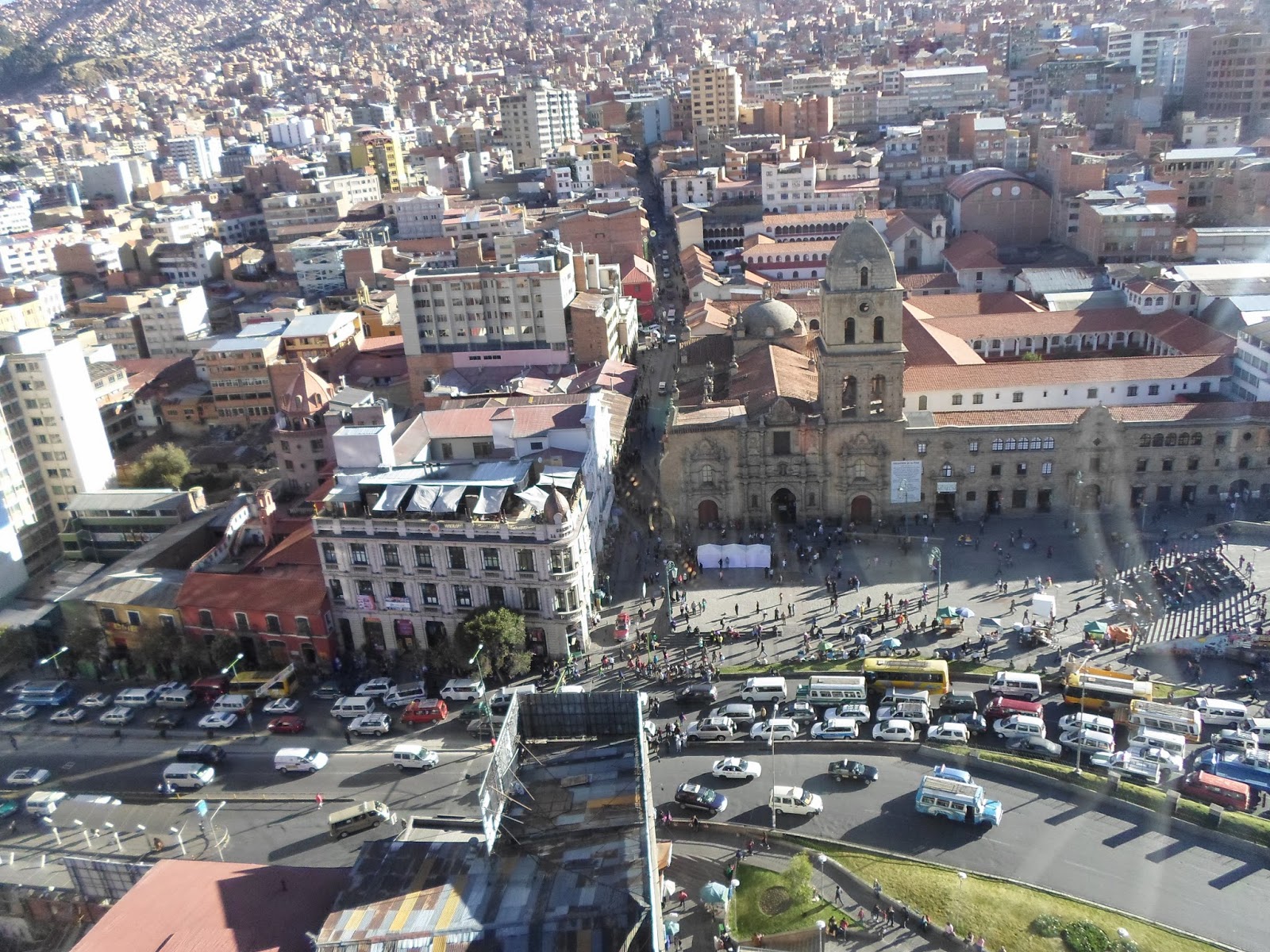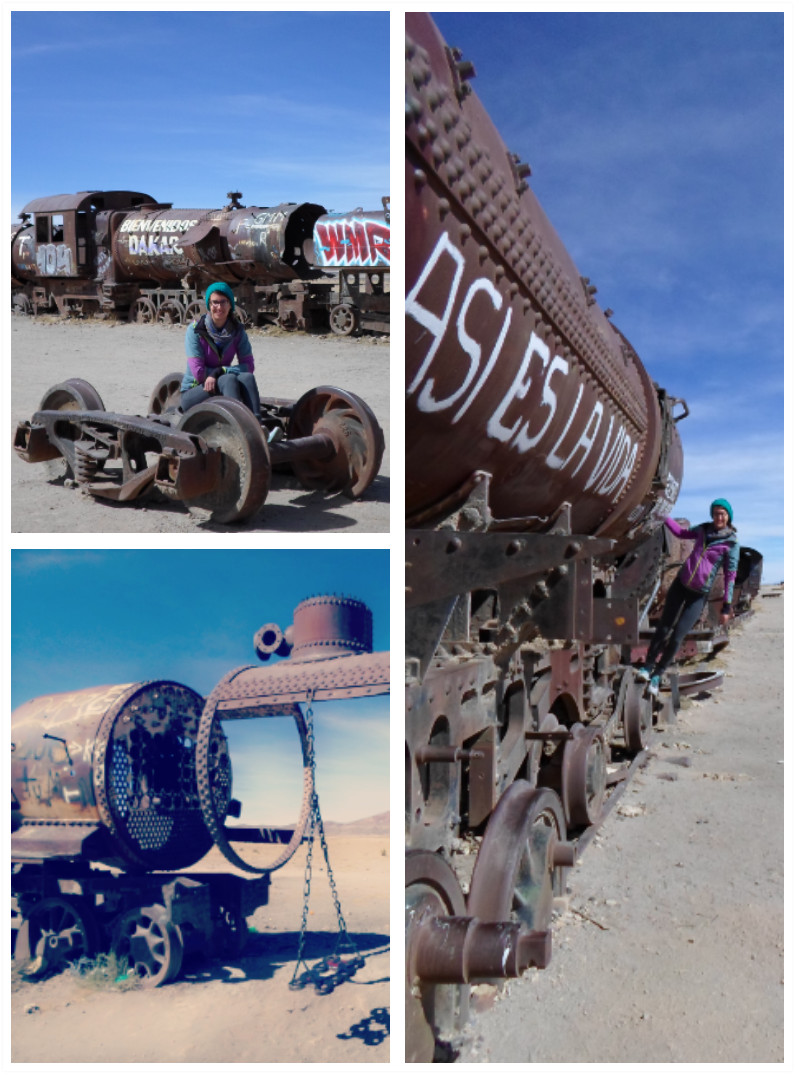Recent weather: 30s during the day, -15 at night in Uyuni; 60s and sunny in Potosi; 70s and sunny in Sucre.
Recent reads: Esther, Job, "Under the Olive Tree" by Courtney Miller Santo.
Truth: The past few days have included some of the most amazing, challenging, and miserable moments of my life.
The 3 Day 4WD Trip to Uyuni Bolivia
Day 1, Friday morning a van took our 12 person group to the Chilean and Bolivian borders. At the Bolivia border I started to feel sick. While altitude sickness would be the most plausible culprit (we were at about 13,100 feet), my symptoms were less head-related and more...well, the other end. At this point, we were in the middle of nowhere, the van was gone, and the 2 SUVs were ready to escort us through the desert. I had no option to go back or call a cab or crawl into bed and wallow. Our Toyota Land Cruiser took off, off roading through the freezing desert with a car full of enthusiastic travelers ready for an epic adventure. And then there was me, in the front seat, praying that I just make it through each minute. It was especially cold. Really cold. Like 6 layers of clothes cold. And with nasty winds of 50-60 mph. That didn't help.
Days 1 and 2 we made many stops along the way throughout la Reserva Nacional de Fauna Andina Eduardo Avaroa
which doubled as bathroom stops for me on the first day.
We arrived at our rustic accommodations the first day at about 4pm where I immediately crawled into my sleeping bag under several blankets for a nap. Once I woke up from my snooze, I felt significantly better. That night, prepared for what was going to be -15 or colder, I slept in pretty much all the clothes I had and survived to tell about it. The second night we stayed in a salt hotel! When I say "salt," I mean salt. The walls, floor, tables were all made of salt. And when I say "hotel," I mean very rustic hostel conditions. It was definitely warmer than the previous night so I wasn't complaining.
Highlights of the national park from the first two days include:
1) Laguna Verde-at the base of Volcan Licancabur is a lagoon which is green in color due to high levels of arsenic and copper. That's right, arsenic.
2) Laguna Colorada-a red lagoon which changes intensity of red depending on the pigment of its microscopic algae life and is the primary home to 3 different species of flamingos. Why the flamingos do head to Florida for the winter beats me.
3) Aguas Termales de Polques-thermal pools that get can get up to 104 degrees F.
4) Geyser Sol De Maňana-at an altitude of over 15,000 feet above sea level, this set of geysers was formed by lava from an active local volcano and constantly expels water vapor and other gases.
 |
| I look cold, right? |
Day 3: We had an early start at about 5:30. This was by far the best and warmest day. Right in the middle of the flat salt plain is a little island of cacti, Isla Inca Huasi, where we watched the sunrise.
 |
| Awaiting the sunset. |
 |
| Think like the cactus. Be the cactus. I am the cactus. |
Then, we headed to the salt flats. The salt flats is a plain as far and as wide as the eye can see in the Atacama Desert of Bolivia made entirely of salt. This is a staple stop for most South American travelers and many, many travelers do this same exact trip that I did. Yet we still found a secluded spot on the salt flats and it felt epic. It's difficult to explain but being there made me feel like a tiny little spot in the corner of our vast world and yet simultaneously, I felt like the captain in charge of this epic ship that was all mine.
It's impossible to come up with an original perspective photo because they've all been done before. However, the 11 of us girls did manage to take some uniquely beautiful photos that are more creative than most but inappropriate to post here. You get the idea.
Lastly, we visited the train cemetery before heading into the small town of Uyuni.
With not much to do in Uyuni, most of our group caught a bus to Potosi. Immediately upon arriving in Potosi, I took a hot shower. I was disappointed to discover that what I thought was a tan was actually just layers of dirt. The rest of the group left on Monday to continue on their way but I stayed in Potosi to check out a silver mine.
Mining is one of Bolivia's only industries and Potosi has been considered one of the richest mines in the world since silver was discovered there by the Spanish in the 1500s. Much economic and political tension revolves around mining. Mining was nationalized during the revolution in 1952 and Bolivia has walked a fine line between aggressively keeping mineral profits within Bolivia while also trying to maintain trade relations internationally. 8% of the male population (women working in the mine and whistling are bad luck) of the town of Potosi work in the mines (not including offshoot industries like those working in the refineries or exporting). However, mineral profits have been steadily declining and the mountain itself is sinking so the mine may only be open another 10-20 years. Afterwhich, Potosi will be a ghost town since they have no other industry.
I can honestly say that going through the mine was one of the most difficult things that I have ever done. I was equipped was boots, pants, jacket, helmet, and headlamp. With the attire alone, I should have known this was going to be more intense than I was expecting. It started with us trudging through a narrow passageway one by one. As we got further into the mine, the passageway got shorter and smaller so I'd often have to duck or crouch and shuffle along through half a foot of muddy sludge. I think a Deutch mine would be more my size.
Once we got about half a mile into the mine, we needed to go up. I stepped up a few rickety wooden stairs and then had to climb up the rest of vertical passage using both hands and feet. I learned the hard way that you need to test each rock handle before putting your full weight on it. We were already at high altitude but as we got further into the mine, it got intensely hot and very dusty as well, making it difficult increasingly difficult to breathe. For the last stretch, there was a small crawlspace that diagonaled up slightly where I was on my belly with my feet dangling off the narrow shaft as I pulled myself inch by inch with my forearms military-style, rocks flying down past me and dropping to the very bottom of the mine. By this point, our group was down to half its original size. If you are at all claustrophobic, this was not the activity for you. Even if you aren't claustrophobic, this may have not been the activity for you still.
That being said, I'm glad I did it because I met Carlos. Carlos is a miner. He is 24 and has been mining for 9 years. Along with his father, he belongs to a cooperative of miners that work the same stretch of the mine together. They don't eat the whole day while they're in the mind because it makes you sick to eat in the passages (that should tell you something). Instead, they chew on a fat cheekful of coca leaves and drink 86% alcohol (it tastes like it could double as naiI polish remover/shoe polish) all day. They decide their own hours but often work 8-16 hour days, 6-7 days a week. The same stretch that I crawled through is Carlos' daily commute except on the return trip, he carries 100 lbs worth of rock on his back! Moral of the story: Be thankful of the job you have!
 |
| In the refinery |
 |
| The mining town of Potosi |
 |
| And then there were 4. The only survivors. |
From Potosi I headed to the beautiful city of Sucre. Sucre was originally Bolivia's capital and the city is still very regal while also having a stronger Spanish vibe than other parts of Bolivia with white-washed buildings and lush plazas. The highlight in Sucre was definitely the breathtaking view of the whole city from the belfry of Templo Se
ňora de Merced.
Next stop: La Paz! Stay tuned!

































.png)















